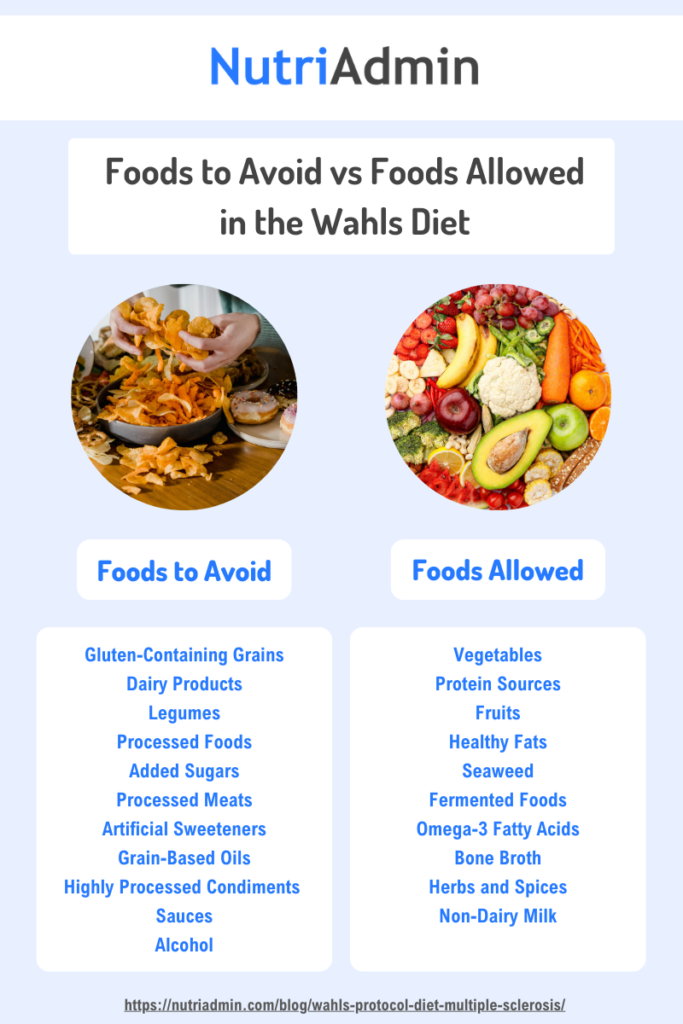The Wahls Protocol diet is very popular in the Multiple Sclerosis (MS) community and among diet enthusiasts. It effectively manages symptoms of MS and enhances the quality of life of people with MS.
Born out of Dr. Terry Wahls’ personal experience with multiple sclerosis, the Wahls protocol is a practical approach to eating that focuses on vegetables, fruits, animals, protein, healthy fats, herbs, and spices.
- What is Multiple Sclerosis?
- What are the Patterns of Multiple Sclerosis
- How does Multiple Sclerosis Happen?
- What are the causes of Multiple Sclerosis?
- What are the Symptoms of Multiple Sclerosis?
- How is Multiple Sclerosis Diagnosed?
- Treatment of Multiple Sclerosis
- Multiple sclerosis and Diet
- What is Dr. Terry Wahls Protocol?
- What is the Wahls Elimination Diet?
- Wahls Protocol Level One
- Wahls Protocol Level Two
- Wahls Protocol Level Three
- Wahls Protocol Diet Meal Plan
- What Supplements does Terry Wahls Recommend?
- Conclusion
- FAQs
What is Multiple Sclerosis?
Multiple sclerosis is a chronic disease that affects the central nervous system. It is an autoimmune condition in which the body destroys its own cells, in this case, cells in the central nervous system.
There are about 2.8 million people all over the world who have been diagnosed with multiple sclerosis, with 107,000 annual cases reported.
What are the Patterns of Multiple Sclerosis
Multiple Sclerosis presents in different patterns. Moreover, studies have been able to identify the major patterns, which are:
Relapsing-Remitting pattern (RRMS): This pattern involves periods of relapse, that is, periods when symptoms get worse and periods of remission (that is, periods when symptoms reduce). Relapses may result from infections or even occur spontaneously. The RRMS is the most common pattern of MS, accounting for about 85% of all MS cases.
RRMS can occur as either Clinically Isolated Syndrome or Benign Multiple Sclerosis.
- Benign Multiple Sclerosis involves almost complete remission between relapses. Over time, there may be little or no accumulation of physical disability.
- Clinically Isolated Syndrome: Here, an individual has a single episode involving neurologic symptoms. These symptoms are relevant clinically as they may be the first sign of multiple sclerosis.
Primary Progressive Pattern: In this pattern, the disease continues to progress without remission or obvious relapses.
Secondary Progressive Pattern: Here, in the initial phase of the disease, the disease starts with a relapsing-remission pattern.
Progressive Relapsing Pattern: In this rare pattern, the disease progresses until a sudden relapse.
Multiple sclerosis is a progressive neurodegenerative disease that can lead to cognitive impairment, poor gait and balance, muscle weakness, walking difficulties, and impaired bladder and bowel control.
Furthermore, MS significantly diminishes the quality of life. It affects both physical activities and the mental state of the individual. No wonder there is a 30 – 40% lifetime prevalence of anxiety and depression in individuals suffering from MS.
How does Multiple Sclerosis Happen?
In MS, the immune system specifically attacks the protective covering of the nerve fibers, that is, Myelin. Myelin acts like a sleeve or sheath for the brain cells. It allows for fast transmission of signals among brain cells and maintains the signal’s strength as it travels along the brain cells (neurons).
When this sleeve is damaged, the transmission of electrical signals is slowed or outright terminated. The term for this process of myelin destruction is demyelination. Sometimes, in multiple sclerosis, the immune system also attacks the nerves that transmit the signals.
The central nervous system comprises the brain and the spinal cord. So, multiple sclerosis affects the cells in this area of the body.
What are the causes of Multiple Sclerosis?
Multiple Sclerosis has no known cause. However, several factors can trigger or propagate the disease.
Genetic Predisposition
Even though genetics play a minor role in the development of multiple sclerosis, it is not a factor to overlook. First-degree family members of individuals with Multiple sclerosis are seven times more likely to develop multiple sclerosis. However, this lifetime risk is about 2-5 – 5%.
Viral Infections
Some viruses have the ability to trigger autoimmune reactions in the body. These viruses may activate dormant T-cels that can specifically attack the Myelin sheath. An example of a virus like this is the Epstein-Barr Virus (EBV). Studies have associated EBV infection with the development of MS for two reasons:
- Individuals with MS express antibodies against specific EBV antigens early on in the disease.
- MS Plaques express a high number of EBV antigens.
Environmental Factors
The influence of the environment and geography is not exactly straightforward. Initially, scientists discovered that equatorial regions of the earth record higher incidences of Multiple Sclerosis than the southern and southern poles. However, the increase in incidences of multiple sclerosis at lower latitudes contradicts this argument.
Vitamin D Levels
Vitamin D is crucial in regulating the immune system’s responses. It reduces the production of proinflammatory cytokines while increasing the production of anti-inflammatory cytokines. Hence, low levels of vitamin D may be a possible factor contributing to the development of Multiple sclerosis.
What are the Symptoms of Multiple Sclerosis?
Symptoms of multiple sclerosis can either be primary, secondary, or tertiary.
Primary symptoms refer to symptoms that arise directly from the destruction of the myelin sheaths of brain cells in the central nervous system. Examples include sensory loss and bladder and bowel dysfunction.
Secondary symptoms arise from complications of the primary symptoms. For instance, urinary tract infections as a result of bladder dysfunction.
Tertiary symptoms arise as psychological and mental health problems as a result of multiple sclerosis. For instance, depression and social isolation are consequences of multiple sclerosis.
How is Multiple Sclerosis Diagnosed?
Most times, Multiple Sclerosis presents with vague symptoms.
- History and physical examinations, together with investigations, help clinicians to make an accurate diagnosis.
- Magnetic Resonance Imaging (MRI): is the preferred image modality for confirming Mutiole Sclerosis and monitoring the disease’s progress in the central nervous system.
- Lumbar puncture: A Lumbar Puncture may be useful when it is impossible to do an MRI.
Treatment of Multiple Sclerosis
There is no cure for Multiple Sclerosis. However, management is broadly divided into Immunomodulatory Therapy (IMT) and Therapy to relieve Symptoms.
Immunomodulatory therapy
To slow disease progression. Most of the best responses to IMTs occur in the early stage of the disease. Some of them include:
- Injectables: Interferon beta medications, Glariarmer acetate
- Orals: Teriflunomide, Dimethyl fumarate, Fingolimod
- Infusions, eg, Natalizumab, Ocrelizumab
- Bruton’s Tyrosine Kinase (BTK)
Therapy to relieve MS Attacks
These include therapies to manage acute Multiple Sclerosis symptoms
- Corticosteroids such as prednisolone and methylprednisolone
- Plasmapheresis
Multiple sclerosis and Diet
Studies have shown the role of diet in multiple sclerosis. For example, one study showed that nutrition and dietary factors are all implicated in the pathology of multiple sclerosis.
Proinflammatory diets play a role in the pathogenesis of Multiple Sclerosis. Diet can increase the production of inflammatory factors such as TNF, interleukins, Prostaglandins, and Leukotrienes. Suppose some diets can induce or trigger multiple sclerosis. In that case, it stands to reason that some other diets may also be able to attenuate or reduce the expression of multiple sclerosis and its symptoms.
This is the basis of the use of diets in the management of Multiple sclerosis such as the Dr. Wahls Protocol Diet.
What is Dr. Terry Wahls Protocol?
The Wahls Protocol is an eating style developed by Dr. Terry Wahls. It is a modified form of the paleo diet, which Dr Wahls developed in response to her diagnosis of Multiple Sclerosis in 2000.
When she tried several medications for multiple sclerosis with little or no results, she decided to use a diet to treat herself. After a while, she began to experience a remarkable recovery.
She discovered a new way of eating that is based on Paleo principles but organized to maximize nutrients that were important for brain function. She tracked vitamins, minerals, antioxidants, and essential fats, all of which she combined to form the Wahls Diet. It is a more intense approach than Paleo to reduce inflammation and aid detoxification.
What is the Wahls Elimination Diet?
The Wahls elimination diet (also known as the modified paleo Wahls diet) was developed by Dr. Terry Wahls in 2008 and is based on the principles of the Paleo diet. The Paleo diet is a restrictive diet that disallows dairy, legumes, and grains and emphasizes fruits, vegetables, meat, and fish.
Another study on the effectiveness of the Wahls diet in 20 individuals with multiple sclerosis over a period of 3 months showed some positive results. After 3 months, fatigue significantly decreased, and at the end of a year, participants reported faster walking speeds and improvements in mood and brain function.

The effectiveness of Wahl’s elimination diet was first demonstrated in a single case report in which the individual experienced improvement in symptoms after consuming the diet.
Moreover, individuals who adhered more to the diet experienced greater improvements.
There are three levels to the Wahls Elimination Diet:
- Wahls Protocol Level One
- Wahls Protocol Level Two
- Wahls Protocol Level Three
Wahls Protocol Level One
This level involves removing gluten, eggs, and dairy from all foods. One easy way to do this is to replace these foods with nine servings of vegetables and fruits every day.
Allowed Foods in the Wahl’s Diet Level One
Foods that are allowed in the Wahls elimination diet include:
- Vegetables: Level 1 places a significant emphasis on vegetables, particularly those that are rich in nutrients. Consume a variety of vegetables, especially leafy greens (3 cups/day), sulfur-rich vegetables like broccoli and cabbage (3 cups/day), and colorful fruits and vegetables (3 cups/day).
- Protein: High-quality protein sources, including Fish (preferably fatty fish like salmon), Poultry (organic or pasture-raised), Grass-fed meat, and Organ meats (such as liver).
- Healthy Fats: Incorporate healthy fats into your diet, including Avocado, Olive oil, Coconut oil, Nuts and seeds (in moderation).
- Fruits: Small amounts of fruits, especially those high in antioxidants and fiber. Berries, in particular, are a good choice.
- Herbs and Spices: You can use a variety of herbs and spices to add flavor to your meals.
- Beverages: You should primarily consume water and herbal teas. Staying hydrated is important.
Foods to Avoid in the Wahls Diet Level One
The following are foods to Avoid in Wahls Protocol Level 1:
- Gluten-Containing Grains: Avoid wheat, barley, and rye, as they contain gluten, which can be inflammatory for some individuals.
- Dairy Products: Avoid all dairy products, including milk, cheese, and yogurt. Dairy can be problematic for those with autoimmune conditions.
- Processed Foods: Exclude highly processed and packaged foods should, as they often contain additives, preservatives, and unhealthy fats.
- Sugars and Sweeteners: Limit or eliminate added sugars, including refined sugars and artificial sweeteners.
- Legumes: Legumes like beans and lentils. Some people with autoimmune conditions find that legumes can be problematic.
- Nightshades: While some versions of the Wahls Protocol exclude nightshade vegetables (like tomatoes, peppers, and eggplants), Level 1 generally allows them. However, some individuals with autoimmune conditions may choose to avoid nightshades due to concerns about inflammation.
- Processed Meats: Processed meats like sausages and deli meats due to additives and preservatives.
Wahls Protocol Level Two
At level Two, this diet seeks to significantly reduce all non-gluten grains, beans, and legumes in addition to the exclusions from Level one. It also adds fermented foods, seaweed, and organic meats.
Foods Allowed in Wahls Protocol Diet Level Two
- Vegetables: Take a wide variety of non-starchy vegetables focusing on leafy greens, colorful vegetables, and cruciferous vegetables (e.g., broccoli, cauliflower, Brussels sprouts).
- Protein Sources: High-quality protein sources, including grass-fed and pastured meats (e.g., beef, lamb, poultry), wild-caught fish (e.g., salmon, mackerel, sardines), organ meats (e.g., liver, heart) for added nutrients like B vitamins.
- Fruits: Berries (e.g., blueberries, strawberries, raspberries) due to their antioxidant content and lower sugar content.
- Healthy Fats: Healthy fats from sources such as avocados, olives, coconut oil, and nuts (in moderation).
- Seaweed: Seaweed, for its iodine and mineral content.
- Fermented Foods: Fermented foods like sauerkraut, kimchi, and kombucha for their probiotic benefits and support for gut health.
- Omega-3 Fatty Acids: Foods rich in omega-3s, such as fatty fish (salmon, mackerel), walnuts, and flaxseeds.
- Bone Broth: Homemade bone broth for its nutrient content and potential benefits for joint health.
- Herbs and Spices: Fresh herbs and spices to season and flavor dishes.
- Non-Dairy Milk: Unsweetened and non-dairy milk alternatives like almond milk or coconut milk.
Foods to Avoid in Wahls Protocol Diet Level Two
The following foods should be discouraged or disallowed in the Wahls elimination diet level two:
- Gluten-Containing Grains: Foods made from wheat, barley, rye, and their derivatives due to their potential to trigger inflammation. This includes bread, pasta, and most cereals.
- Dairy Products: Dairy, including milk, cheese, yogurt, and butter. Some individuals with autoimmune conditions may have sensitivities to dairy proteins.
- Legumes: Beans and lentils because they contain compounds that some people with autoimmune conditions may be sensitive to.
- Processed Foods: Highly processed foods, which often contain preservatives, artificial additives, and unhealthy fats. This includes most packaged snacks, sugary beverages, and fast food.
- Added Sugars: Avoid foods and drinks with added sugars. This includes sugary snacks, candies, sodas, and desserts.
- Processed Meats: Processed meats like sausages, hot dogs, and deli meats typically contain additives and preservatives and are best avoided.
- Artificial Sweeteners: Artificial sweeteners are discouraged due to their potential impact on gut health and metabolism.
- Grain-Based Oils: Refined vegetable oils like soybean oil, corn oil, and canola oil are minimized in favor of healthier fats like olive oil and coconut oil.
- Nightshade Vegetables: Some individuals with autoimmune conditions choose to avoid nightshade vegetables, such as tomatoes, peppers, eggplants, and potatoes, as they may exacerbate inflammation in some cases.
- Highly Processed Condiments and Sauces: Many store-bought condiments and sauces contain additives, preservatives, and added sugars. Homemade or carefully selected options are preferred.
- Alcohol: While occasional, moderate alcohol consumption may be acceptable for some, it’s generally discouraged due to potential interactions with medications and its impact on overall health.
Wahls Protocol Level Three
Wahls Level Three is the ketogenic version of the Wahls diet. It involves eliminating all grains and legumes from the diet and eating six cups of vegetables daily. It also introduces additional sources of fats, such as fatty fish and avocados.
Foods Allowed in Wahls Protocol Diet Level Three
- Non-Starchy Vegetables: The cornerstone of this level is non-starchy vegetables. You should aim to consume at least 9 cups of these vegetables per day. This category includes foods like leafy greens (kale, spinach, collard greens), cruciferous vegetables (broccoli, cauliflower, Brussels sprouts), and other colorful vegetables (carrots, beets, bell peppers).
- High-Quality Protein: Protein sources in Level 3 come from high-quality animal products. This can include fatty fish (such as salmon and mackerel), grass-fed meats (beef, lamb), organ meats (liver, heart), and poultry.
- Healthy Fats: Healthy fats are encouraged and can be obtained from sources like avocados, nuts (such as walnuts and almonds), seeds (flaxseeds, chia seeds), and olive oil. Omega-3 fatty acids from fatty fish are emphasized for their anti-inflammatory properties.
- Fruits: You can include a limited amount of deeply colored fruits like berries (blueberries, strawberries, raspberries), which are rich in antioxidants. However, fruit consumption should be moderate due to their natural sugar content.
- Herbs and Spices: Flavor your dishes with herbs and spices like turmeric, ginger, garlic, and herbs like basil and oregano, which have anti-inflammatory properties.
- Supplements: Depending on your individual needs and health status, you may need to take certain supplements, as recommended by Dr. Wahls. Common supplements include vitamin D, B vitamins, and omega-3 fatty acids.
Foods to Avoid in Wahls Protocol Diet Level Three
Avoid or limit the following foods on Level 3 of the Wahls Protocol:
- Grains: All grains, including wheat, rice, corn, and gluten-containing grains, are eliminated.
- Legumes: Beans, lentils, and other legumes are not included in this level.
- Dairy: Dairy products are typically eliminated or minimized because they can be inflammatory for some individuals.
- Processed Foods: Highly processed foods, sugary snacks, and foods with artificial additives and preservatives should be avoided.
- Soy: Soy products are typically avoided due to concerns about their potential impact on hormone balance and inflammation.
- Nightshades: Some individuals on the Wahls Protocol may choose to limit or avoid nightshade vegetables like tomatoes, peppers, and eggplants, as they can be problematic for some people with autoimmune conditions.
Wahls Protocol Diet Meal Plan
Understanding the different levels of the Wahls diet makes developing a Wahls protocol meal plan easy for nutritionists and dieticians.
Some meal plan generators allow seamless plan creation. One such generator is NutriAdmin, software for nutritionists, dieticians, and coaches to create easy-to-follow meal plans.
It is also a nutrition analysis software that can help you calculate the correct macros and micros for all food recipes and diet plans. It has a rich recipe database of easy-to-make and balanced recipes.
Moreover, here is a sample of an AI-generated meal plan for the Wahls protocol diet using NutriAdmin.
What Supplements does Terry Wahls Recommend?
Dr. Wahls has a list of supplements that she recommends to strengthen the body against multiple sclerosis symptoms. Some of them include:
- Omega 3- fatty acids: To combat inflammation and support brain health. They are also known for their anti-inflammatory properties
- Vitamin D supplementation is important for optimal brain function and immune health. Studies have shown that Vitamin D deficiency is a risk factor for several immune disorders. Hence, this supplement is very important to prevent them.
- Vitamin B: Vitamin B complex is important for energy production and brain cell function. They also aid the repair of myelin structures and support DNA repair and detoxification.
- Zinc: Zinc is important in immune system function and body cell growth. It also helps in tissue and gut repair.
- Curcumin is the active compound obtained from turmeric. It is anti-inflammatory and can also help to regulate the immune system and reduce inflammation in the central nervous system.
- Magnesium has important roles in neuromuscular function. It is also involved in several biochemical reactions that take place in the body, ranging from energy production to DNA synthesis
Conclusion
Multiple Sclerosis (MS) is a debilitating autoimmune condition that affects millions worldwide, significantly diminishing quality of life through a range of physical and cognitive symptoms. The Wahls Protocol, a diet plan developed by Dr. Terry Wahls, presents a dietary approach to managing multiple sclerosis, emphasizing nutrient-dense foods to support brain function and reduce inflammation. By eliminating gluten, dairy, and processed foods while incorporating a variety of vegetables, high-quality proteins, and healthy fats, the Wahls Protocol aims to attenuate MS symptoms and promote overall well-being.
Research indicates that the Wahls Protocol diet plan can yield positive outcomes for some individuals with multiple sclerosis, including reduced fatigue, improved mood, and enhanced physical function. However, the effectiveness of the diet can vary, and it may be more beneficial for those with less severe disability.
Ultimately, the Wahls Protocol offers a structured dietary framework that prioritizes nutrient-rich foods to support health and manage MS symptoms. While it may not halt disease progression, it can significantly enhance the quality of life for individuals with MS, providing a complementary approach alongside traditional medical treatments.




